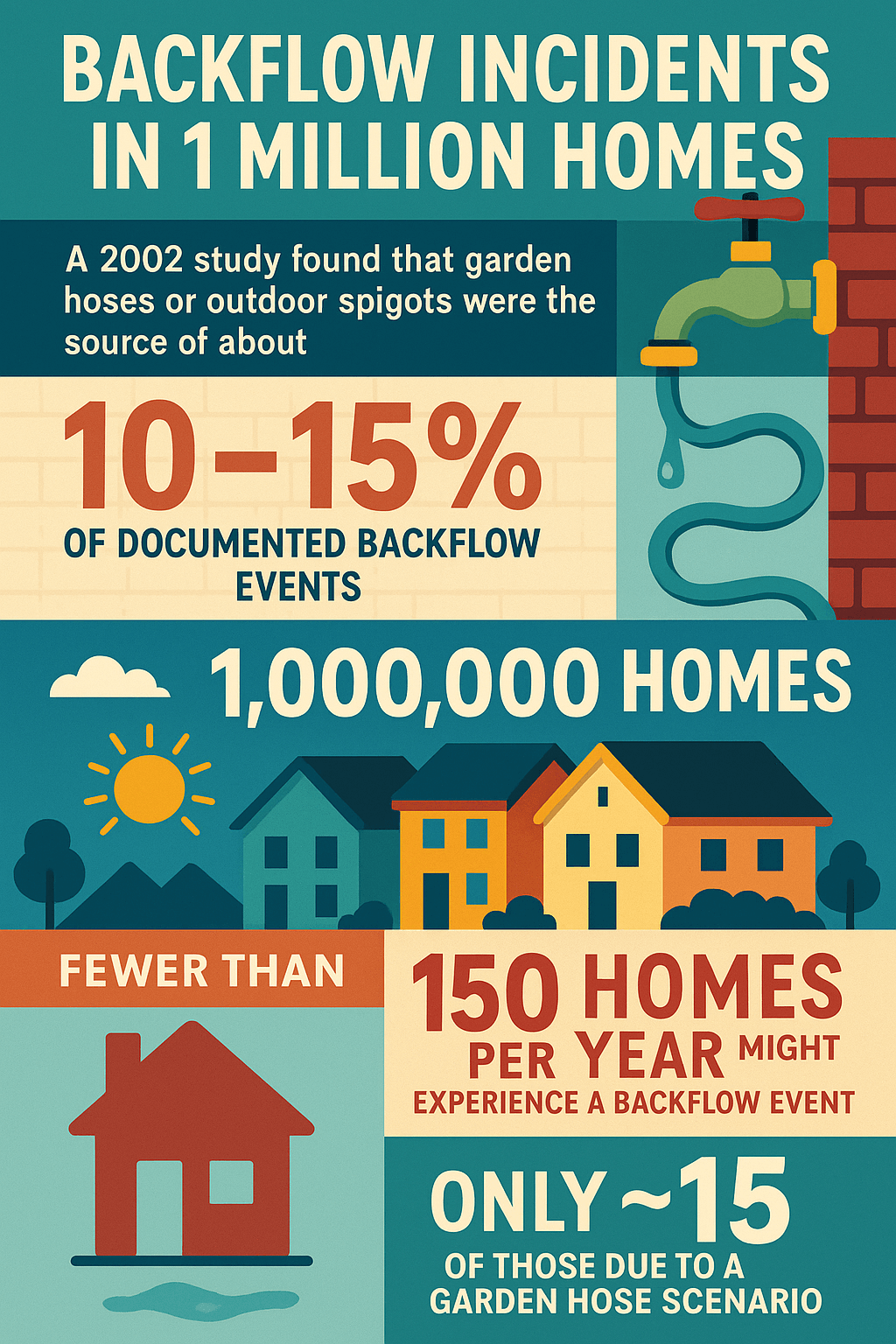Does Drinking From The Hose Present Health Risks to People?
The short answer: It depends.
Outdoor hose water originates from the municipal water supply, which powers your household taps. The main variation occurs between the spigot and your mouth. Outdoor spigots and hose water lack regulations for water consumption that match drinking water standards, and rightfully so.
DON’T BREAK THE BANK: Affordable Plumbing Solutions
The Hose Itself
Most garden hoses do not contain safe materials for consumption. Cost-effective PVC hoses made from inexpensive materials may break down to release lead, phthalates, BPA, and multiple dangerous contaminants, which become more likely during exposure to sunlight and heat. The Ecology Center conducted research to demonstrate that certain hoses release dangerous contaminants into water that develop through sunlight exposure.

So, How Much Is Too Much?
For a person to get sick from hose water, a few things would need to happen:
- They’d need to drink a significant amount of water that’s been sitting in the sun in a cheap, non-drinking-safe hose.
- It requires repeated, long-term exposure to reach harmful levels of most contaminants.
The risk is very low for occasional use (e.g., a few sips while gardening or a kid spraying themselves in summer), especially if you flush the hose for a few seconds before using it.
Don’t Panic!
Drinking water-safe hoses exist on the market under RV or marine hose labels. They use polyurethane or rubber materials without dangerous additives. Purchasing drinking water-safe hoses proves to be a worthwhile investment for any family that wants to drink water from their garden hose occasionally.
Standing Water in the Hose
Hoses allow water to heat up to extreme temperatures when they sit idle during hot summer days. Bacteria find perfect conditions to multiply inside the stagnant water of hoses, especially when these hoses are used to clean animals, surfaces, and fertilizers. However, a few seconds of running water will help eliminate dangerous microbes from the drinking water supply.
Can Hose Water Backflow Into My Plumbing System?
This one’s more of a plumbing curiosity—but an important one.
Non-drinkable water can flow backward into household plumbing systems through a process known as backflow. When your primary water supply pressure drops (such as during a water main rupture), the system becomes open to receiving non-drinkable water that flows in reverse direction. Contaminated water from a submerged hose connected to an operational spigot will flow into your home’s clean water system.
So Here is The Millon Dollar Question: How Likely is This to Happen?
Let’s face it: most of us look at facts differently. We hear something online, and we consider it a force that needs to be dealt with now. But the reality is we must get all the facts to discover the truth about any subject. We could easily leave this paragraph out of the equation, but doing so would be very deceptive. So we’ll let you decide if it is something you choose to plan for.
Estimated Risk:
Backflow incidents from residential homes are rare but not zero. According to studies by water utilities and plumbing safety organizations:
- A 2002 study by the American Backflow Prevention Association found that about 10–15% of documented backflow events in residential properties originated from garden hoses or outdoor spigots.
- The majority of these cases occurred during water main breaks, fire hydrant usage nearby, or system flushing—all events that create a sudden pressure drop.
If we take an average residential neighborhood of 1,000 homes:
- Less than 1 or 2 homes per year might experience a backflow event at all.
- And only a small portion of those (likely 10–15%) would be directly linked to a garden hose scenario.
That means we’re talking about a ~0.01–0.02% annual chance per household of hose-based backflow—extremely rare but technically possible.

Let’s Take it a Step Further:
Out of 1,000,000 homes in a year:
- 1,000–2,000 homes may experience a backflow incident (0.1%–0.2%)
- 100–300 of those would be from garden hoses/spigots (0.01%–0.03%)
That’s equivalent to:
- 1 to 3 homes per 10,000 potentially having hose-related backflow annually
So yes, it’s possible—but extremely rare. Again, with a $10 vacuum breaker, the odds approach zero.
YOUR PLUMBING SYSTEM: Spooky Sounds and What They Signify
How Do You Prevent It?
After understanding those numbers, the majority of outdoor spigots include vacuum breakers, which function as basic devices that stop backflow. These inexpensive devices are simple to install and provide valuable peace of mind to homeowners. MVP Plumbers can check the vacuum breakers where you reside in Murrieta, Temecula, Menifee, Lake Elsinore, or surrounding cities.
Does My Yard Hose Use The Same Water Source That Feeds My Household Plumbing System?
The answer is affirmative for nearly all houses in the Inland Empire region and its neighboring areas. The outdoor hose bib receives water supply directly from the municipal network, which powers your kitchen sink, bathroom shower, and washing machine.
Different Pathways Between Them
The essential distinction between these two water sources emerges from the intervening components. The main difference between indoor and outdoor water supply lines is the installed plumbing equipment. Water passes through different pathways between its source and point of use. So, while they may be from the same source, they clearly have different pathways. The difference lies in what’s in between—the fixtures. Your indoor plumbing may be filtered, softened, or otherwise treated, while outdoor spigots are often a straight shot from the main line. That means:
- No water filtration
- No softening (unless your setup reroutes it, which is rare)
- No special treatment for outdoor use
This is why if you have a whole-house water filtration or softening system, you’ll notice a big difference in taste and feel between your indoor tap and outdoor hose.
In Conclusion, Here is Some Advice, Science, and Review
Chemicals: Older or low-quality hoses, especially when hot, leach unsafe compounds. Lead and BPA are the main concerns. People who want to drink from hoses should choose products that bear “SF/ANSI 61 “certification.
Bacteria: When the Hose remains idle, and the Water heats up, organic materials inside the hose create an environment that fosters bacteria. Running the Water for several seconds before use effectively minimizes potential risks.
Backflow Risk: Preventable with vacuum breakers. The occurrence of backflow problems remains rare except when specific conditions exist.
Remember the Risk: The facts show that only 1 or 2 homes out of 1000 will have a backflow issue annually, and only 10 to 15% of those homes will include a hose.
So, Should You Drink Hose Water?
Honestly? Drinking from a garden hose during occasional yard work poses no danger to an average person. Healthy adults and children face minimal risks, but run the hose for a minute before drinking. People who grew up drinking from hoses during their summertime backyard experiences will agree with me about the satisfaction of consuming hose water. The experience transcends hydration because it creates memories while uniting people to a more straightforward way of life.
Final Thoughts: Don’t Fear the Hose, Just Be Smart
We don’t need to fear every droplet of unfiltered water. Common sense, basic hygiene, and a little science can help ensure that your hose water moments stay safe and enjoyable.
Here’s what you can do:
- Upgrade to a drinking-safe hose.
- Install a vacuum breaker on outdoor spigots.
- Flush the hose before drinking.
- Keep hoses out of buckets or pools when not in use.
- Don’t water your plants with softened water.
Whether you’re in Temecula trimming hedges, in Menifee playing with the kids, or watering your Murrieta backyard garden, hose water still has a place in our lives. Just like we did as kids—stay curious, stay hydrated, and when in doubt, let it run a second or two.













